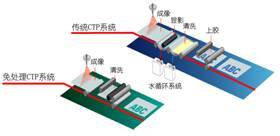The development of CTP technology has come a long way in the past 10 years. The media technology has always been the core of CTP. At present, there are three types of mature media technologies: photosensitive silver salt plates, photosensitive photopolymer plates, and thermal plates. These three kinds of media have excellent performance for different printing market demands. Compared with traditional film making, it has made great progress in terms of print quality, print resistance, and ease of handling.
The three kinds of plates commonly used in the market can be referred to as traditional CTP plates. Why is it so? It's because they all require chemical developer after exposure. There are three main aspects of the effect of the chemical treatment of the developing medicine. First, the impact on the print quality, the change of flushing conditions directly affects the reproduction accuracy of the outlets. Second, the impact of the environment, the chemical waste generated during the treatment process need to be treated to discharge. Third, it increased costs.

Fig.1 Comparison between traditional CTP system and process-free CTP system
Free processing of plates is one of the development directions of CTP plates. In Figure 1, the left side is an exempt CTP system, and the right is a traditional CTP system. Compared with the conventional system, the exemption system is superior to the traditional system in printing quality, environmental protection, and cost reduction. AGFA's Azura plate is based on the Thermofuse technology and is a truly chemical-free processing plate. This article will explore the principles of hot-melt technology and some of the features of Azura's chemical-free processing media.
Development of Thermal Plates
The thermal plate has undergone three generations of development, preheating the plate, preheating the plate, and handling the plate.
The first generation of the thermal plate is a negative plate, preheating prior to development, and the plate structure is aluminum plate and heat sensitive. At 830 nm laser exposure, the acid catalyst in the coating promotes cross-linking of the resin in the coating, forming a latent image. Before development, the plate was exposed to a high temperature of about 140°C, and the latent image formed part of the printing plate. Unexposed parts do not react at high temperatures. During development, the unexposed portion is dissolved in an alkaline developer, and the exposed plate is a blank portion of the plate. After rinsing, the plate can be coated with protective or baking plates.
The second generation thermal plate was a positive version, eliminating the preheating process. The principle of the plate is: The thermosensitive coating on the plate base is ink-friendly, and it is insoluble in alkaline potions. After exposure, the coating absorbs energy, increases solubility, and can be dissolved in alkaline solutions. The exposed portion is dissolved during development, forming a blank portion of the printing plate. The non-exposed part is reserved for the graphic part of the plate. After development, it is generally cleaned and glued, and then printed on the machine. At present, most users of the thermal CTP are using the second-generation thermal plate.
The third generation of thermal plate technology development goal is to avoid processing. No-treatment plate technology can be divided into three categories, thermal ablation technology, polarity conversion technology and hot melt technology.
The thermal ablation plate is generally a double layer coating, the bottom layer is an ink-receptive layer, and the upper layer is a hydrophilic layer. When exposed, the laser energy ablates the hydrophilic layer, exposing the ink-receptive layer and forming a graphic. The unexposed portion still retains its hydrophilic nature and is a blank space on the layout.
Thermal ablation technology does not perform well in successful commercial applications. There are two main factors that constrain the development of this technology. The first is how to deal with ablative dust, and the second is printability. Dust and debris generated after ablation can affect the accuracy of the optical part of the platesetter, and have an impact on health and the environment. The use of this technology requires an additional dust treatment recovery device. In terms of printing performance, blank parts of the traditional PS plate and CTP plate are aluminum plate bases after matte and oxidation treatment, and have good hydrophilicity and resistance to printing. The blank part of the thermal ablation plate is a hydrophilic coating, and its ink balance control ability and print resistance are not ideal.
The polarity conversion technology eliminates the need for processing of a single-layer coating on a plate, and the coating is hydrophilic (or lipophilic). After exposure, the polarity of the coating changes and turns into lipophilic (or hydrophilic). The exposure part is a plate graphic (or blank). This technical plate can be directly printed on the machine without any treatment after exposure. The factor that restricts the development of this technology is still printability. The part of the ink and ink is coated with a film, and both the printing control and the resistance to printing are greatly constrained, and there is still a long way to go for realizing large-scale commercial applications.
Hot-melt technology is the real commercial application technology in the third-generation free-handling plate. The blank part of the printing plate is the aluminum base after the frosting and oxidation treatment, not the coating of the coating film, and the printability does not have any difference with the ordinary printing plate.